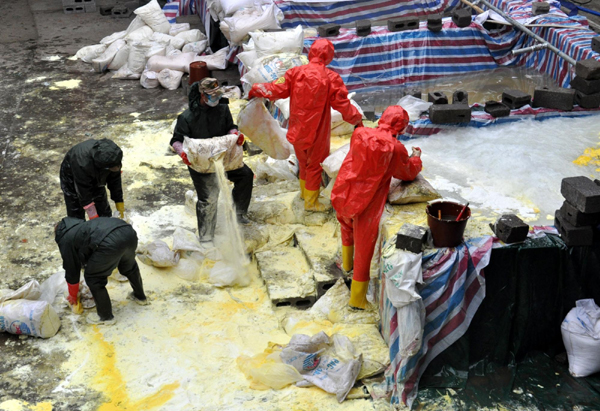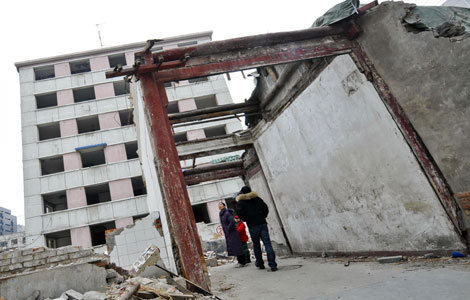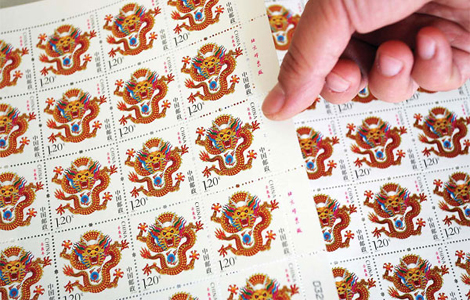Cadmium spill no threat to HK, Macao: expert
Updated: 2012-01-29 09:31
(Xinhua)
|
|||||||||
LIUZHOU, Guangxi - Water and environmental authorities in South China's Guangxi Zhuang autonomous region are working to control cadmium pollution in a local river, while ruling out the possibility that water sources for Hong Kong and Macao have been contaminated.
Cadmium pollutants may be double the restricted level in the downtown section of the Liujiang River in the city of Liuzhou, but authorities are making efforts to contain the contamination within the required standard, said Xu Zhencheng, an expert with the task force handling the pollution emergency.
 |
|
Armed police dump bags of alkali into water to dissolve the contamination at the Nuomitan waterpower plant in Liucheng county of Liuzhou city, Guangxi Zhuang autonomous region, Jan 27, 2012. [Photo/Xinhua] |
Xu is a deputy chief of the South China Environmental Science Institute under the Ministry of Environmental Protection.
The water supply for residents in Liuzhou remained safe by mid-day Saturday, the Mayor of Liuzhou Zheng Junkang said.
"We will spare no effort in ensuring the safety of drinking water," Zheng said. "In case the tap water supply is suspended, the government will do its best to resume supply in the shortest time possible."
The mayor said the government has activated a contingency plan to tap into the 3.5 tons of underground water reserves once the original drinking water source was polluted.
Cadmium is a carcinogenic chemical mostly used in industrial effluents.
The pollutant was detected in the Liujiang River Thursday afternoon, more than 10 days after industrial waste from a local mining company spilt it into the Longjiang River, a tributary upstream of the Liujiang River, according to the city's environmental protection bureau.
Flocculent has been dumped into a dam on the Longjiang River in order to promote the flocculation of the pollutants. The chemicals can help suspended heavy metal particles aggregate, facilitating the dredging of the pollutants when they form a floc.
In an aim to curb potential sources of new pollution, environmental authorities in the city of Hechi, where the contamination originated, have ordered a suspension of production at all seven heavy metal producers along the upstream section of the Longjiang River.
More than 60 percent of cadmium content in the Longjiang River in Hechi, which was previously reported as five times higher than the restricted level, has been diluted and absorbed, according to experts.
They said no contamination has been spotted in the downstream Qianjiang, rivers of Xunjiang and Xijiang -- a trunk of the Pearl River which forms major water source for Guangdong province and neighboring Hong Kong and Macao special administrative regions.
The 500 million cubic meters of water at the Honghua Hydropower Station on the Liujiang River is expected to substantially dilute the pollutants, and, therefore, cadmium will be contained within the restricted level in the waters downstream of the station, Xu said.
However, the spill has caused panic buying of bottled water in parts of Liuzhou, a city with a population of 3.7 million.
A supermarket salesperson in the city's downtown area said sales of bottled water had more than tripled in recent days.
"Some people bought 10 cardboard boxes of bottled water at a time," the salesperson said, adding that the store has ample stock, and there is no immediate threat to supply despite the surge in demand.
The local market watchdog has moved to ensure that prices for bottled water remain stable and supplies are sufficient in case the pollution prompts panic buying.
Guangxi Jinhe Mining Co Ltd has been held responsible for the contamination.
Related Stories
Cadmium pollution spreads in tainted river 2012-01-27 09:31
River contaminated with cadmium in S China 2012-01-20 16:16
Cadmium pollution flows downstream in tainted river 2012-01-27 16:53
Drinking water safety monitored after cadmium pollution 2012-01-28 11:50
Hot Topics
Kim Jong-il, Mengniu, train crash probe, Vaclav Havel, New Year, coast guard death, Internet security, Mekong River, Strait of Hormuz, economic work conference
Editor's Picks

|

|

|

|

|

|







